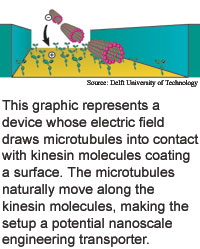
Electricity controls biomolecules
Several groups of researchers are working
to control kinesin and microtubules, a pair of proteins that in biological
cells form a train-and-track structure for structural support, transportation
and communications.
Researchers from Delft University of Technology in the Netherlands
and the Max Planck Institute of Molecular Cell Biology and Genetics in
Germany have found a way to use electricity to control the way microtubules
connect with kinesin-coated structures.
In cells, kinesin transports cargo by walking along long, stiff
microtubule filaments. The Delft and Max Planck researchers' control mechanism
inverts the relationship of the proteins. They attached kinesin molecules
to microfabricated gold surfaces and coaxed the molecules to propel microtubule
filaments over the surfaces. The microtubules moved over distances of
2 to 10 microns. A micron is one thousandth of a millimeter.
The researchers flowed microtubules in fluid over the gold surfaces;
when they applied an electric field to the gold surfaces, the negatively
charged microtubules were drawn to their kinesin molecule docks. When
they turned the electric field off, the microtubules detached from the
kinesin and floated off the surface.
It should be possible to build nanoscale electrodes that precisely
control the movements of the microtubules, according to the researchers.
The researchers are aiming to use the proteins to perform technological
tasks on the nanoscale. In theory, these types of devices could give researchers
precise control over matter at the molecular scale, and many individual
devices could be used in parallel.
The researchers are working on ways to load cargo on individual
shuttles and to actively steer and direct individual microtubules.
The work appeared in the January 8, 2005 issue of Nano Letters.
Stories:
Tool turns English to code
Common sense boosts speech software
Inkjet prints human cells
How it Works: Biochips
Briefs:
Nanowires track molecular activity
Microdroplet makes mighty microscope
Cheap material makes speedy memory
Tiny crystals adjust laser colors
Electricity controls biomolecules
Nanotubes juice super batteries
Layers promise cheap circuits

Research Watch blog
View from the High Ground Q&A
How It Works
RSS Feeds:
News
Ad links:
Buy an ad link
Ad links: Clear History
Buy an ad link
|
TRN
Newswire and Headline Feeds for Web sites
|
© Copyright Technology Research News, LLC 2000-2010. All rights reserved.